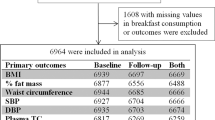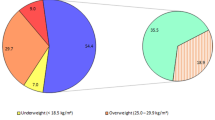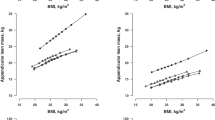Abstract
The relationships between eating frequency and adiposity and cardiovascular risk factors have been poorly investigated in children. To evaluate this issue, anthropometric indices and blood pressure (BP) were measured in 3668 children, aged 6–11 years. Meals/snack frequency, assessed by a questionnaire, was ‘Low’ in 332 (⩽3 meals/day), ‘Intermediate’ in 1334 (4/day) and ‘High’ in 2002 (⩾5/day) children. Body mass index (BMI) and waist circumference significantly decreased going up across meals/snacks categories (BMI=20.5±0.2, 19.7±0.1 and 18.8±0.1 kg/m2; waist=68.0±0.6, 66.6±0.3, 63.9±0.2 cm, for Low, Intermediate and High groups, respectively; M±s.e.; P<0.001 by ANCOVA trend analysis adjusted by age, sex, birth weight, physical activity, parental overweight and education level). BP decreased from Low to High group but differences were no longer significant after adjustment for BMI. In our sample of school children, the daily eating frequency was inversely associated with the degree of both total adiposity and central fat deposition.
This is a preview of subscription content, access via your institution
Access options
Subscribe to this journal
Receive 12 print issues and online access
$259.00 per year
only $21.58 per issue
Buy this article
- Purchase on Springer Link
- Instant access to full article PDF
Prices may be subject to local taxes which are calculated during checkout
Similar content being viewed by others
References
Taylor E, Missik E, Hurley R, Hudak S, Logue E . Obesity treatment: broadening our perspective. Am J Health Behav 2004; 28: 242–249.
Samuelson G . Dietary habits and nutritional status in adolescents over Europe. An overview of current studies in the Nordic countries. Eur J Clin Nutr 2000; 54 (Suppl 1): S21–S28.
Ruidavets JB, Bongard V, Bataille V, Gourdy P, Ferrieres J . Eating frequency and body fatness in middle-aged men. Int J Obes Relat Metab Disord 2002; 26: 1476–1483.
Louis-Sylvestre J, Lluch A, Neant F, Blundell JE . Highlighting the positive impact of increasing feeding frequency on metabolism and weight management. Forum Nutr 2003; 56: 126–128.
Titan SM, Bingham S, Welch A, Luben R, Oakes S, Day N et al. Frequency of eating and concentrations of serum cholesterol in the Norfolk population of the European prospective investigation into cancer (EPIC-Norfolk): cross sectional study. BMJ 2001; 323: 1286–1290.
Redondo MR, Ortega RM, Zamora MJ, Quintas ME, Lopez-Sobaler AM, Andres P et al. Influence of the number of meals taken per day on cardiovascular risk factors and the energy and nutrient intakes of a group of elderly people. Int J Vitam Nutr Res 1997; 67: 176–182.
Drummond SE, Crombie NE, Cursiter MC, Kirk TR . Evidence that eating frequency is inversely related to body weight status in male, but not female, non-obese adults reporting valid dietary intakes. Int J Obes Relat Metab Disord 1998; 22: 105–112.
Jenkins DJ, Josse RG, Jenkins AL, Wolever TM, Vuksan V . Implications of altering the rate of carbohydrate absorption from the gastrointestinal tract. Clin Invest Med 1995; 18: 296–302.
Barba G, Giacco R, Clemente G, Venezia A, Russo P, Grimaldi C et al. The BRAVO Project: screening for childhood obesity in a primary school setting. Nutr Metab Cardiovasc Dis 2001; 11 (Suppl. 4): 103–108.
Barba G, Troiano E, Russo P, Venezia A, Siani A . Inverse association between body mass and frequency of milk consumption in children. Br J Nutr 2005; 93: 15–19.
Fogteloo AJ, Pijl H, Roelfsema F, Frolich M, Meinders AE . Impact of meal timing and frequency on the twenty-four-hour leptin rhythm. 3. Horm Res 2004; 62: 71–78 [Epub 2004 Jun 21].
Farshchi HR, Taylor MA, Macdonald IA . Regular meal frequency creates more appropriate insulin sensitivity and lipid profiles compared with irregular meal frequency in healthy lean women. Eur J Clin Nutr 2004; 58: 1071–1077.
Farshchi HR, Taylor MA, Macdonald IA . Deleterious effects of omitting breakfast on insulin sensitivity and fasting lipid profiles in healthy lean women. Am J Clin Nutr 2005; 81: 388–396.
Farshchi HR, Taylor MA, Macdonald IA . Decreased thermic effect of food after an irregular compared with a regular meal pattern in healthy lean women. Int J Obes Relat Metab Disord 2004; 28: 653–660.
Farshchi HR, Taylor MA, Macdonald IA . Beneficial metabolic effects of regular meal frequency on dietary thermogenesis, insulin sensitivity, and fasting lipid profiles in healthy obese women. Am J Clin Nutr 2005; 81: 16–24.
Westerterp-Plantenga MS, Goris AH, Meijer EP, Westerterp KR . Habitual meal frequency in relation to resting and activity-induced energy expenditure in human subjects: the role of fat-free mass. Br J Nutr 2003; 90: 643–649.
Boutelle K, Neumark-Sztainer D, Story M, Resnick M . Weight control behaviors among obese, overweight, and nonoverweight adolescents. J Pediatr Psychol 2002; 27: 531–540.
Cho S, Dietrich M, Brown CJ, Clark CA, Block G . The effect of breakfast type on total daily energy intake and body mass index: results from the Third National Health and Nutrition Examination Survey (NHANES III). J Am Coll Nutr 2003; 22: 296–302.
Rampersaud GC, Pereira MA, Girard BL, Adams J, Metzl JD . Breakfast habits, nutritional status, body weight, and academic performance in children and adolescents. J Am Diet Assoc 2005; 105: 743–760.
International Obesity Task Force, Position Paper. Waiting for a green light for health? Europe at the Crossroads for Diet and Disease 2003, www.iotf.org/media/eurobesity.pdf.
Author information
Authors and Affiliations
Consortia
Corresponding author
Appendix A
Appendix A
The ARCA Project Study Group:Agriculture Department, Campania Region: M Bianco, A Tallarico (SeSIRCA) F Alvino, M Ferrante, U Fiorentino (STAPAL Avellino).Institute of Food Sciences, CNR: G Barba, L Bruno, P Russo, A Siani, E Troiano, A Venezia.ASL Av1: G Capobianco, V Cavalli, P Corvino, L Delli Paoli, T Del Viscovo, A Donatiello, MG Falco, I Giusto, F Guardascione, C Macchia, A Mastromarino, G Nicoletta, E Pennarola, M Prudente, A Rabuano, G Sena, E Tenore, MA Ternulli.ASL Av2: G Amatucci, R Baciarelli, C Casullo, L Curto, C D'Avanzo, A Di Filippo, N Pescatore, A Spina, R Ziccardi.ASL Na5: MR Izzo, M Viti.
Rights and permissions
About this article
Cite this article
Barba, G., Troiano, E., Russo, P. et al. Total fat, fat distribution and blood pressure according to eating frequency in children living in southern Italy: the ARCA project. Int J Obes 30, 1166–1169 (2006). https://doi.org/10.1038/sj.ijo.0803257
Received:
Revised:
Accepted:
Published:
Issue Date:
DOI: https://doi.org/10.1038/sj.ijo.0803257
Keywords
This article is cited by
-
Eating frequency is inversely associated with blood pressure and hypertension in Korean adults: analysis of the Third Korean National Health and Nutrition Examination Survey
European Journal of Clinical Nutrition (2014)
-
Associations between energy intake, daily food intake and energy density of foods and BMI z-score in 2–9-year-old European children
European Journal of Nutrition (2014)
-
Association between dairy product intake and abdominal obesity in Azorean adolescents
European Journal of Clinical Nutrition (2012)
-
What do children understand? Communicating health behavior in a European multicenter study
Journal of Public Health (2010)



